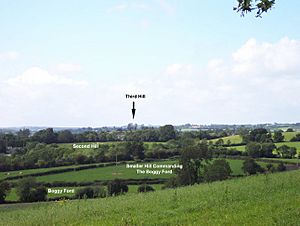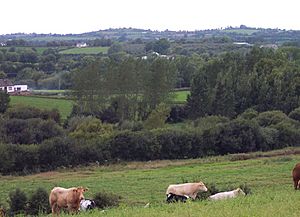Battle of the Yellow Ford facts for kids
Quick facts for kids Battle of the Yellow Ford |
|||||||
|---|---|---|---|---|---|---|---|
| Part of the Nine Years' War | |||||||
 View along the Yellow Ford battlefield looking north-west |
|||||||
|
|||||||
| Belligerents | |||||||
| Commanders and leaders | |||||||
| Henry Bagenal † Calisthenes Brooke Thomas Wingfield Maelmora O'Reilly † |
Hugh O'Neill Hugh O'Donnell Hugh Maguire |
||||||
| Strength | |||||||
| ~4,000 | ~5,000 | ||||||
| Casualties and losses | |||||||
| ~1,500 killed ~300 deserted |
~low | ||||||
The Battle of the Yellow Ford was a major fight during the Nine Years' War in Ireland. It happened on August 14, 1598, in County Armagh. An English army of about 4,000 soldiers, led by Henry Bagenal, was trying to reach a fort that was under attack.
This fort, called Blackwater Fort, was being besieged by an Irish army. The Irish forces were led by Hugh O'Neill. As the English marched from Armagh towards the fort, O'Neill's army attacked them. The English army was badly defeated.
During the battle, the English column was split up. A large dirt wall stopped their advance. Bagenal was killed, and many of his soldiers died or were hurt when an English gunpowder wagon exploded. About 1,500 English soldiers were killed, and 300 left the army. After this big loss, the Blackwater Fort gave up to O'Neill. The battle made the war much bigger, as England sent more troops, and many Irish lords joined O'Neill.
Contents
Why the Battle Happened
In 1597, the English built a new fort on the Blackwater River. This fort was about five miles northwest of Armagh, an English town. Soon after it was built, Hugh O'Neill, Earl of Tyrone began to attack it.
By 1598, the soldiers inside the fort were running out of food and supplies. The English government thought about leaving the fort because it was deep inside O'Neill's territory. It was also very close to O'Neill's main base, Dungannon.
Sir Henry Bagenal, an English commander, believed the fort should be supplied. In early August 1598, he was chosen to lead the mission to bring supplies to the fort.
O'Neill's Preparations
When O'Neill heard that a large English army was coming, he asked O'Donnell and his fighters to help. O'Donnell quickly brought his soldiers, both foot soldiers and horsemen, along with troops from Connacht. All the Irish forces from Ulster also joined O'Neill's army. They were ready to face the English before they even reached Armagh.
O'Neill's troops dug trenches and blocked roads with cut-down trees. They also built low walls of brushwood. The area was hilly, with forests, bogs, and some fields. Bagenal knew the five miles to the fort were full of places for ambushes. But he thought his army could handle small attacks and win any big fight. Since the main road was blocked, Bagenal decided to march along low hills and cross the River Callan.
The Armies
Henry Bagenal was a very experienced English commander in Ulster. He had fought against Irish lords for ten years. He had a strong dislike for O'Neill, partly because O'Neill had married his sister Mabel without Bagenal's approval.
Bagenal commanded about 3,500 foot soldiers. These soldiers used pikes (long spears) and muskets (guns). When marching in dangerous areas, musketeers were on the outside to shoot, and pikemen were inside to protect them. Bagenal also had 350 cavalry (horse soldiers) and some cannons.
O'Neill's army had about 5,000 soldiers. Unlike older Irish armies, most of O'Neill's men had calivers, which were lighter and easier-to-carry muskets. They also had pikemen and "targeteers." Targeteers were Irish soldiers trained by Spanish advisors. They used swords and small shields to protect O'Neill's gunners.
O'Neill had English and Spanish military experts who trained his troops. His army was different from the English "pike and shot" style. O'Neill created an army that used a lot of gunfire but also moved quickly. His cavalry, however, was less modern. They still used spears in the traditional Irish way.
The Battle Begins
The English army was divided into six groups: two at the front, two in the middle, and two at the back. The cavalry was in the middle. As soon as they left Armagh, Irish soldiers hidden in bushes on both sides started shooting at them.
The front of the English army, led by Sir Richard Percy, crossed the River Callan without trouble. But as Percy's group moved forward, large gaps appeared between the English soldiers. People later said they marched as if they were rushing to "win a football match."
Percy's group then crossed a muddy area called the 'Yellow Ford'. This ford gave the battle its name. It was a raised path through the bog. Bagenal's group, carrying supplies and cannons, fell behind. One heavy cannon got stuck in the mud and had to be left behind.
The Trench and the Explosion
Percy's group climbed a second hill. There, they found a mile-long trench and dirt wall blocking their way. The trench was five feet deep, and the wall was five feet high, topped with thorns. Even with Irish gunfire from the sides, Percy's group went down the hill and over this barrier. The trench was not defended, and O'Neill did not try to stop them.
When Percy's group reached the top of a third hill, they could see the Blackwater Fort. The soldiers in the fort were happy, hoping for rescue. But their hopes were soon crushed.
The English groups at the back had stopped at the River Callan. The rest of the English army was stuck on the second hill. O'Neill sent more troops to attack Percy's men. This forced the English musketeers to move closer to their pikemen. This allowed O'Neill's soldiers to shoot at the crowded English troops from close range. Irish horsemen and swordsmen began to break through the English pike defense.
Under heavy attack, Bagenal told Percy to retreat back over the trench. But the retreat was messy. The leading English group was defeated. The trench had cut off Percy's men from their cavalry. It also made it hard for the English foot soldiers to retreat, as they fell over each other into the ditch.
Marshal Bagenal led his men forward to help. But as he went down the hill towards the trench, he was shot in the head and killed. The English tried to fight back, but O'Neill's forces pushed them back over the trench.
English Retreat
Thomas Maria Wingfield took command of the English army. Things got worse when an English soldier tried to get gunpowder from a supply wagon. He still had a lit match from his gun. Two to four hundred pounds of gunpowder exploded! This killed and wounded many soldiers and covered the hill in smoke. This disaster made the Irish attack even harder.
Wingfield had no choice but to order a retreat back to Armagh. But the commander of the English rear group either didn't get the order or refused it. He launched another attack across the trench, which O'Neill quickly crushed. Only quick action by Wingfield and the English cavalry saved 500 men.
The rest of the English forces struggled back to Armagh. The Irish tried to cut off their retreat at the River Callan. But the English used their remaining cannon to stop the Irish advance. Finally, the English got a break as the Irish shooting slowed down. The Irish had run out of gunpowder. An English captain later said that if O'Neill's pikemen had attacked then, no English soldiers would have survived. The English army finally made it back to Armagh.
After the Battle
About 1,500 English soldiers were killed in the battle. This included 18 officers. Three hundred soldiers left the English army and joined the Irish side. Out of 4,000 soldiers who started from Armagh, just over 2,000 returned.
Those who reached Armagh were then surrounded by O'Neill's army. The English cavalry managed to escape south. After three days of talks, it was agreed that the English troops could leave Armagh. But they had to leave their weapons and ammunition behind. The Blackwater Fort also had to surrender.
The most badly wounded English soldiers were left in Armagh Cathedral. Many had severe burns from the gunpowder explosion. O'Neill agreed to care for them and send them to Newry when they were well enough to travel.
The English claimed that 200 to 300 of O'Neill's soldiers were killed. However, this number is probably too high.
After this big victory, England quickly sent many more soldiers to Ireland. Many Irish lords who had been neutral decided to join O'Neill's alliance. So, the battle made the war much bigger and more intense.
See also


